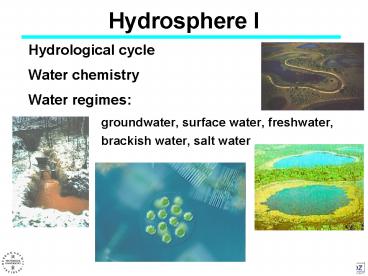Hydrosphere I PowerPoint PPT Presentation
1 / 17
Title: Hydrosphere I
1
Hydrosphere I
- Hydrological cycle
- Water chemistry
- Water regimes
- groundwater, surface water, freshwater, brackish
water, salt water
2
Water retention times
3
Chemical composition of water
- dependent on
- climate
- annual season
- hydrology
- mineral composition of soils and bedrock
- source
- surface discharge
- Near surface GW
- deep groundwater
- type of aquifer
- modified by
- ion exchange equilibria
- precipitation reactions
- mixing and dilution
- Nutrient uptake and recycling
- exchange with atmospheric gases
- input of anthropogenic solutions s.l.
4
Chemical components of river water
- dissolved ions and molecules
- ions adsorbed onto colloid-particles and onto
suspended sediment - chemistry of the colloids
- microorganisms (bacteria, algae, fungi)
- dissolved gases dependent on TW and PXatm
5
Major elements in natural stream water
mg L-1
- SKonz.HI TDS mg L-1
- TDS 33 (Congo) to 880 (Rio Grande, TX) Danube
and Rhine (307) avg. 110 - fresh water lt 1 000
- brackish water 100010000
- salt water 10 000100 000
- salt brine gt100 000
6
TDS versus c
- destilled water lt 3 µS cm-1
- rain and snow water 10100 µS cm-1
- fresh water lt 1 000 mg L-1 lt 1440 µS cm-1
- brackish water 100010 000 mg L-1 1440 14
400 µS cm-1 - salt water 10 000100 000 mg L-1 14 400 144
000 µS cm-1 - salt brine gt100 000 mg L-1 gt 144 000 µS cm-1
- c electrical conductivity (µS cm-1 25C)
- c25 5.48 1.43 bFT
- bFT filtrate dry residue (mg L-1)
7
Trace elements in natural freshwaters
A Salomons Förstner B Chester C Salbu
Steinnes
8
Trophic state
- Measure for intensity of primary production
- Eutrophic, mesotrophic and oligotrophic
- Dystrophic high in humic acids
- concept of natural eutrophication during lake
succession (aging) - Cultural eutrophication
9
Dissolved gases
- Henrys law Cs Ks Pt
- Cs saturation concentration
- Ks solubility coefficient, temperature-dependent
- Pt partial pressure
- Temperature increase decreases solubility
- Further reactions? (CO2, H2S, NH3)
10
Solubility of gases in freshwater
- at partial pressures of 1013 hPa
at atmospheric partial pressures
11
Oxygen
- Most important parameter to limnologists
- Addition to lake/river
- from atmosphere
- photosynthesis
- Removal from lake/river
- respiration of organisms
- mineralisation of organic matter
- to atmosphere
12
Oxygen in rivers
- Processes similar to lakes
- Additional re-oxygenation in rapids, waterfalls,
shallows - Sewage effluent, street irrigation, wastes etc.
from urban areas have high BOD (biological oxygen
demand) and lead to an oxygen sag at point of
entry in river
13
Oxygen levels and redox potential
- Oxygenated water (e.g., 10 mg L-1)
- redox potential positive (e.g., 500 mV)
- ions in oxidised form (Fe3, NO3-, SO42-)
- Low oxygen (lt 2 mg L-1)
- redox potential low, even negative in sediments
- ions in reduced form (Fe2, NH3-, H2S)
14
Inorganic Carbon
- CO2-diffusion across air/water interface (Henrys
law) dissolution and stepwise dissociation - speciation is pH-dependent usually HCO3-
-dominated - dissolution of calcium carbonate (limestone) by
carbon dioxide-containing water - CaCO3CO2H2O ? Ca(HCO3)2
- bicarbonate only, if dissolved carbon dioxide
present (equilibrium carbon dioxide), otherwise
re-precipitation of calcium carbonate
15
Disturbances to Equilibrium
- Removal of CO2 CaCO3 precipitation, pH rise
- pressure decrease (e.g. travertine), temperature
increase - photosynthesis (marl lakes, lake whitening, e.g.
5-15 g m-3 after primary production maximum
phosphate co-precipitation possible) - Addition of CO2 CaCO3 dissolution, pH decrease
- respiration (hypolimnion, soil)
- CO2 increase in atmosphere
- Carbonate acts as important buffer!
16
Nitrogen
- nitrate input from inflow, terrestrial runoff and
precipitation (previously underestimated!). - in situ nitrogen fixation by blue-green algae,
bacteria (Azotobacter, Chlostridium) or Alnus - nitrate predominant in the epilimnion, can be
used up during blooms ammonia predominant in the
eutrophic hypolimnion and reducing sediments. - nitrite only at low concentrations unstable.
17
Phosphorus
- rare and limiting nutrient (in water only few
µg/l bioavailable, needed for ATP) - naturally from minerals, e.g. apatite
precipitation, atmospheric particles not from
natural soils! - anthropogenic from agriculture and detergents
- total phosphate (TP) dissolved inorganic
phosphate (DIP, orthophosphate) dissolved
organic phosphate (DOP) total particulate
phosphate (TPP, not biologically available).

